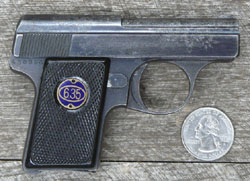It seems like there are more opinions about the caliber of one's gun than just about anything else. You have no doubt heard it all. "I'll never carry anything less than a .45." "Shot placement is key." "Hydro-static shock" Buzz words fly as fast as the expletives in this argument because everyone has an opinion and hardly any of us have first hand experience. While it's good that most of us have never had to shoot someone, it does leave a data vacuum into which all sorts of opinion enters.
Here are some facts and a little opinion from my point of view:
Fact: Most pistol calibers are sub-standard when compared to rifle and shot shell ballistics. I won't quote figures here. Just search out the numbers if you don't believe me.
Fact: It's hard to stuff a rifle in your pants pocket. That's why they make hand guns.
Fact: A bird in the hand is worth more than ........Well you get the picture.
It comes down to compromises. Size vs. effectiveness is always the name of the game. In this game, even a .44 magnum is a compromise. People choose to carry hand guns because they are portable and concealable, not because they are the most effective thing in a fire fight.


Now, I submit to you this statement: The reason most people don't carry a 12 gauge shotgun under their winter coat is the same reason I don't want to carry a 1911 in my shorts pocket in July. It's too damn big. You have to ask yourself, "Do I want to dress around a gun"? If the answer is no, you have a choice to make. Carry a really small gun or don't carry one at all.
 |
| Small |
 |
Really small
|
Once you've decided to carry a really small gun, a choice is upon you. How small is small enough? And, how much power am I willing to give up to get the size down?
It used to be that any gun under 6 inches long was a .25, or .22, but times have changed. The age of the pocket .380 is upon us in all of it's polymer glory. Kel-Tec, Taurus, and Ruger are all big players in this market, though they are certainly not alone. These little automatics take the .380 acp cartridge and put it in a package that is roughly 5 inches long, weighing in at 8-10 ounces. That is very light. The fact that .380 firepower is available in a true pocket gun is an incredible feat of engineering.
But, even these new wonder guns have drawbacks. Greatest of all is recoil. When you put a .380 cartridge into something that light, there will be recoil. Some of us are more sensitive to it than others, but recoil does affect all shooters in some way. Mainly it's the timing of follow up shots or simply the ability to keep a hold on a gun the size of an I phone 5 under recoil.
And, as small as they are, they are not the smallest pistols ever made.
The world's gun makers did a brisk business in pocket pistols throughout the first half of the 20th century. These guns were generally chambered in .22 rimfire, .25 ACP, or .32 ACP. None of these cartridges are man stoppers, but all were carried. Apparently deep concealment was of great importance. And, if you want a 4 inch long gun, it will not be chambered in .45 ACP.
Perhaps the smallest gun you will ever hold is one of the NAA mini revolvers. Made by North American Arms, these little single action revolvers are offered in a number of configurations. Calibers range from .22 short to .22 mag. They offer 5 shots, but are single action.
So, It's all up to you and the weather. In 30 degrees, sure, I'll take that 1911 under a coat. In 95 degrees, give me the pocket gun, a pair of shorts, and a T shirt.
 |
| WALTHER MODEL 9 |
 |
| north american mini revolver |



.JPG)
.JPG)
.JPG)
.JPG)




